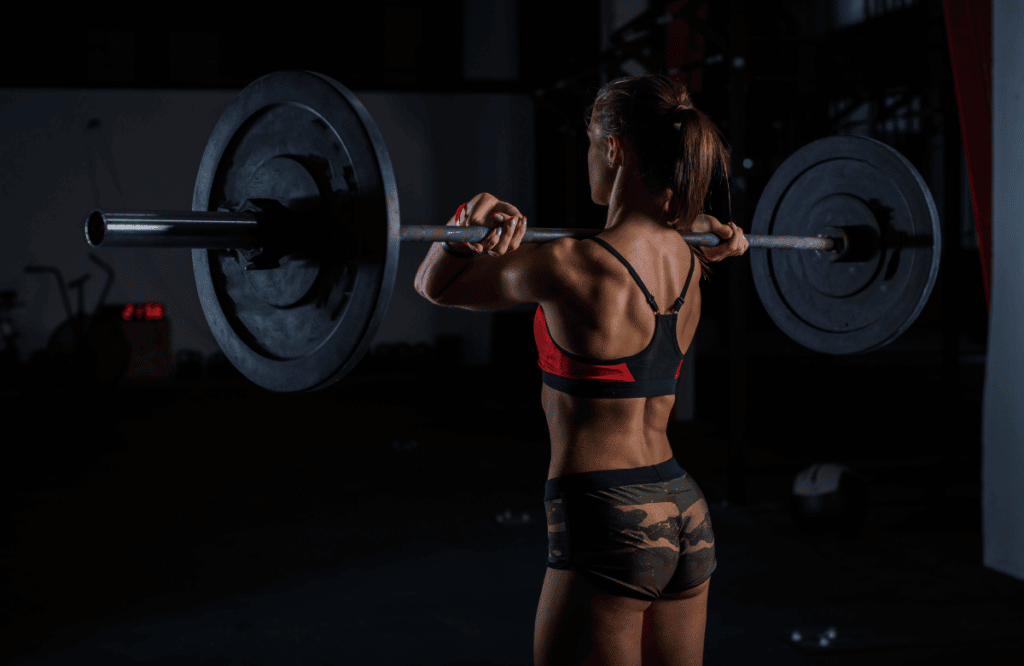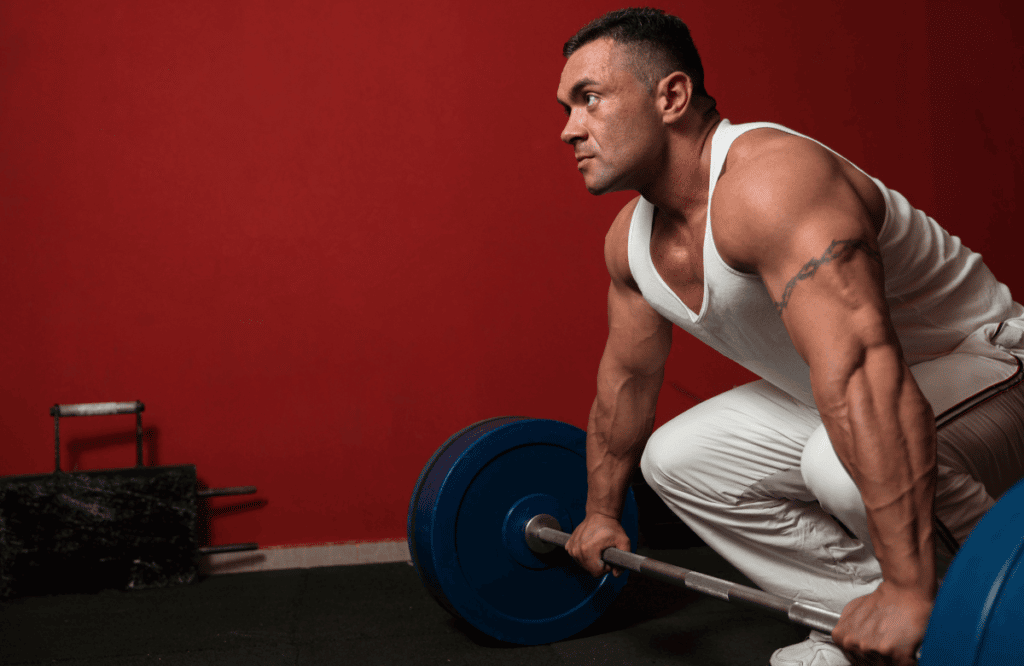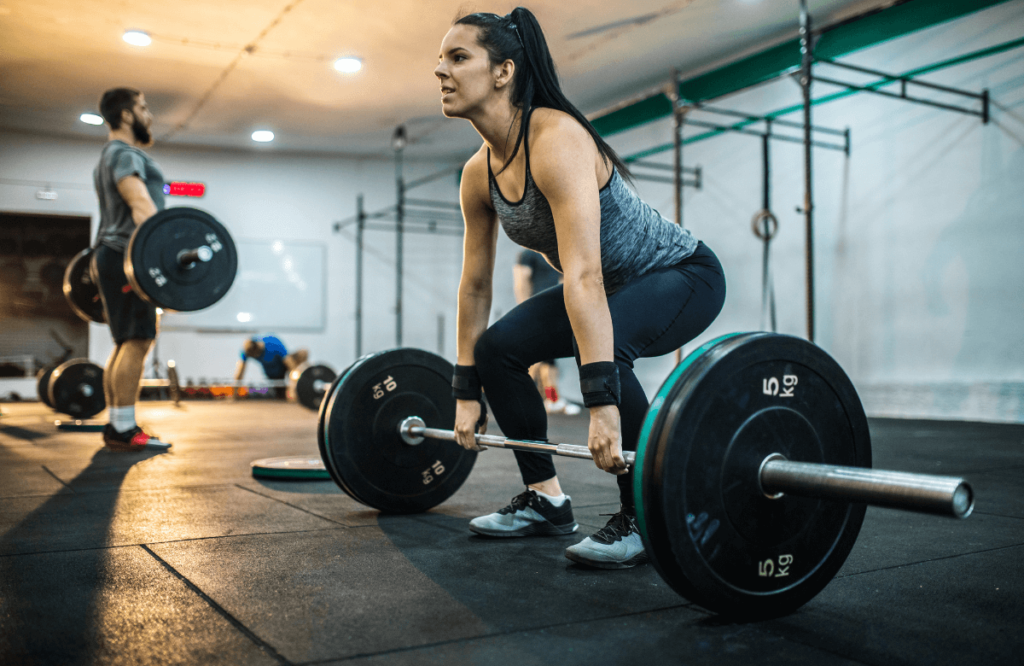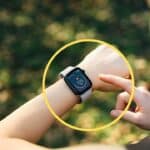The deadlift is often known as the ‘king of exercises‘. It has earned this title because of the amount of muscles the deadlift works. In terms of bang for your buck, few exercises manage to offer the same strength and muscle activation benefits of the deadlift. But do you know what muscles do deadlifts work?
Depending on the variation you use, pulling the bar from the floor to a standing position, using proper form through the full range of motion uses most of the major muscles in the body. It’s a fantastic compound exercise, challenging everything from grip strength to abdominal strength.
As well as the strength training benefits, it’s an incredibly functional exercise. The movement pattern in a deadlift is one that is used in everyday life by almost all of us.

Jump to:
Introduction to the Deadlift – Movement Fundamentals
One of the challenges when explaining the deadlift muscles worked issue is the amount of variation that exists within the exercise. The word ‘deadlift’ is basically an umbrella term for a huge variety of exercises where a hip hinge movement pulls a load from the floor to an upright position.
Whilst this is great from a training standpoint (because it offers lifters huge variation and a range of training effects), each variation changes the effects of the exercise dramatically.
To make sure this article is evidence based and accurate, the claims made about deadlift muscles worked will be backed by science. I’ll be using published electromyographic analysis (EMG) data, which has tested muscle activation in many common deadlift variations.
At the end of the article you’ll know exactly which muscles each type of deadlift works!
Deadlift Muscles Worked – How Variation Affects Things
Without going into exhaustive detail, here’s a snapshot of different deadlift types. You’ll see from the different techniques how there’s emphasis on the different muscles…
We’ll cover these variations and more in our analysis. The point at this stage is to show you that just because exercises share the title ‘deadlift’, it doesn’t mean they’re all exactly alike. This explains why and how they can work different muscles.
You’ll already know that deadlifts work the quad muscles, the gluteal muscles, the core muscles and the back muscles. My job in this article is to explain how each deadlift variation changes the muscles worked.
Conventional Deadlift Muscles Worked
We’ll start with the main event – the conventional deadlift. This is the most common deadlift variation you’ll see in gyms. It’s also the exercise you’ll see in most deadlift training programs.
The technique with the conventional deadlift involves two distinct phases… A large leg drive, followed by a hip thrust/hip extension. This means it requires a significant initial push from the quads to get the bar moving. There’s support from the spinal erectors on the way up. At the top, there’s a large drive from the glutes. On the descent, control of the bar comes from the spinal erectors and the hamstrings.
Martin-Fuentes et al assessed EMG data of deadlifts and its variants in a 2020 study. Their findings are in alignment with many others. They helped to conclude…
Primary conventional deadlift muscles worked:
- Quads
- Glutes
- Spinal erectors
- Lats
- Hamstring
Secondary muscles worked:
- Forearms
- Upper back
- Core (abdominal region – back activation is major)
The conventional deadlift is arguably the most balanced deadlift overall. It works the front and back of the legs, plus the glutes and back equally. Most deadlift training programs will focus on the conventional style deadlifts for this reason.
Romanian Deadlift Muscles Worked
The Romanian deadlift is a variation that became widespread in the 1990’s. It’s not as common or as popular as some other forms because it’s more specialised. Here’s a reminder of technique…
The Romanian deadlift is a variation that involves very little quad engagement and instead, loads the hamstrings significantly. The lack of pronounced knee extension limits quad engagement, and emphasises the work done by the hamstrings. It’s important to use the correct form here, otherwise you over-stress the lower back.
This was confirmed by Lee et al in their 2018 study comparing conventional and Romanian deadlifts. It’s a style that is often used by Olympic weightlifters to help with their pulling strength, because it mimics the movement patterns they use.
Primary Romanian deadlift muscles worked:
- Hamstrings
- Glutes
- Spinal erectors
- Lats
Secondary muscles worked:
- Quads
- Forearms
- Upper back
- Core (abdominal region – back activation is major)
The Romanian deadlift is a more specialised variant and should be used to target the hamstrings, lower back and glutes. It’s not an effective deadlift for building quad strength. It’s used to target specific aspects of training, such as the first pull in weightlifting.
Hex or Trap Bar Deadlift Muscles Worked
The ‘hex’ or trap bar deadlift is a way of deadlifting ‘within’ the bar. Some lifters like this more because it puts less stress on the lower back. There is variation within the trap bar deadlift, because of the different shapes of trap bar. Here’s what it looks like…
There are mechanical advantages to the trap bar deadlift that allow the lifter to pull more weight relative to standard deadlifts. Having the weight either side, rather than in front of you means the forces on the back and hips are lower, as found by Andersen et al in their 2018 EMG comparison of barbell and hex bar deadlift versus hip thrusts.
The exercise is less stressful on the hips, offers the same amount of back activation, and engages the quads well. The hamstrings aren’t as activated as with the barbell, probably because the weight isn’t as far forward. This can reduce the core muscles engagement, but only slightly.
Primary hex bar deadlift muscles worked:
- Spinal erectors
- Glutes
- Quads
- Lats
Secondary muscles worked:
- Hamstrings
- Forearms
- Upper back
- Core (abdominal region – back activation is major)
If you’re looking for pure numbers, or want to limit stress on the lower back, this is the one for you. If you use the lower handles, you significantly increase the amount of quad activation as well. This is because you start the lift with a lower hip position.
Stiff-Leg Deadlift Muscles Worked
The stiff-leg deadlift is more aligned with the Romanian deadlift than any of the conventional style deadlifts . It’s an exercise designed to limit the work done by the quad muscles. It does this by stiffening the knee joint. This lack of knee extension forces the hamstrings to work more, especially in the eccentric phase.
The stiff-leg deadlift loads the hamstrings more than any other common deadlift variation. What’s also interesting though is how it trains the calf muscles. This was discovered by Bezerra et al in their 2013 study of ‘Electromyographic Activity of Lower Body Muscles during the Deadlift and Stiff-Legged Deadlift‘.
It shouldn’t be a large surprise, given the extra loading that the stiff-leg deadlift places on the posterior chain compared to standard deadlifts. The starting position at the top of each lift forces the hips back, which exaggerates the eccentric phase of the lift. This will load the hamstrings and posterior chain more.
Primary stiff-leg deadlift muscles worked:
- Hamstrings
- Spinal erectors
- Glutes
- Quads
- Lats
- Calves
Secondary muscles worked:
- Quads
- Forearms
- Upper back
- Core (abdominal region – back activation is major)
The stiff-leg deadlift is an interesting exercise, because although it shares a lot of the techniques with other forms of deadlift, the muscle activation is completely different. It’s an excellent compound exercise and arguably the most effective exercise for the hamstrings we have.
Sumo Deadlift Muscles Worked
The sumo deadlift is an interesting exercise, because it looks very different from regular deadlifts. A sumo deadlift has a different range of motion, stresses the leg muscles for longer and has a different effect on leg muscle hypertrophy. This is the sumo deadlift…
The wider leg stance at the start of the sumo deadlift shifts more the effort onto the leg muscles. This also suits the taller lifters, because the wide legs allow for a lower hip position. This reduces lumbar spine loads and increases leg muscle activity. The legs do most of the work getting the lifter to the upright position.
Escamilla et al performed ‘An electromyographic analysis of sumo and conventional style deadlifts’ in 2002. Their interesting discovery was that the greater the knee flexion, the greater the muscle activation of the middle trapezius. The more limited the knee flexion, the more the upper traps were engaged. There’s possibly more back activation in the sumo deadlift due to the more upright position of the torso, and the close grip.
Primary sumo deadlift muscles worked:
- Quads
- Glutes
- Traps
Secondary muscles worked:
- Forearms
- Lats
- Lower back
- Core (abdominal region – back activation is major)
The sumo deadlift shifts more emphasis on the leg muscles than any other deadlift. It has the potential to stimulate leg muscle growth, and some people find they can lift heavier weights this way. The closer grip also helps to improve grip strength more.
Deadlift and Posterior Chain
When it comes to deadlift muscles worked, we can’t ignore the impact it has on the muscles of the posterior chain. These include all of the muscles that run up the back of the body – from the calf muscles to the upper back.
Deadlifts have two distinct phases – a leg drive, then a hip drive. This trains different muscles of the posterior chain depending on the phase of the move.
When lifting heavy loads from the floor to a standing position, we have to use the correct form. Without that, we risk serious injury to the lower back and hips in particular. Taking heavy loads through such a long range of motion absolutely has to engage the core muscles, the gluteal muscles and the leg muscles. This helps us maintain a neutral spine and reduce the risk of injury.

Most Effective Deadlift For Muscles Worked
When it comes to deadlift muscles worked, there’s no single ‘most effective’ variation. It depends on your goals….
If you’re looking to improve your strength for everyday life, the conventional style deadlifts are the one for you. They offer great muscle and strength balance. The load and effort is spread across the legs, the gluteal muscles and the back muscles.
It’s also the main exercise for general deadlift strength training. If you’re looking to lift heavy weights, it’s the go-to deadlift. There’s a reason most elite powerlifters pull in a conventional deadlift style.
If you want to improve leg strength, you should go with the sumo style deadlift. It’s the one that places most of the load on the legs.
If you want to reduce the strain on your lumbar spine, go with the trap bar deadlift. If you lift with the lower handles, you’ll also help to work the legs more. This is due to the low hip position.
If the goal is to strengthen the hamstrings, use a stiff-leg deadlift. Electromyographic analysis shows it engages the hamstrings and calf muscles more than the other styles.
Romanian deadlifts are great for training the hamstrings and glutes. They also have excellent weightlifting carryovers.

Switching up the deadlift muscles worked
There are several different ways you can change the deadlift muscles worked. All of these will have an impact on how the exercise is performed, therefore the muscles used…
- Including a step to perform a deficit deadlift increases the work done by the legs.
- Changing your grip – whether overhand grip, alternating grip, underhand grip or hook grip makes a difference to forearm activation.
- Range of movement makes a difference – using a rack pull for example. This reduces leg engagement, and makes the back do more of the work.
- Performing deadlift training with dumbbells and kettlebells instead of barbells will change muscle emphasis too.
- Changing your grip width can have an impact too. Positioning the hands closer or wider will change the deadlift muscles worked as well.
The deadlift is one of the best exercises we have for adding muscle mass, building strength and improving functional fitness. As long as you use correct technique to protect your back and prevent injury, it’s safe to perform all of the common deadlift variations.All of the deadlift variations assessed here have been checked against the electromyographic data from various studies.















